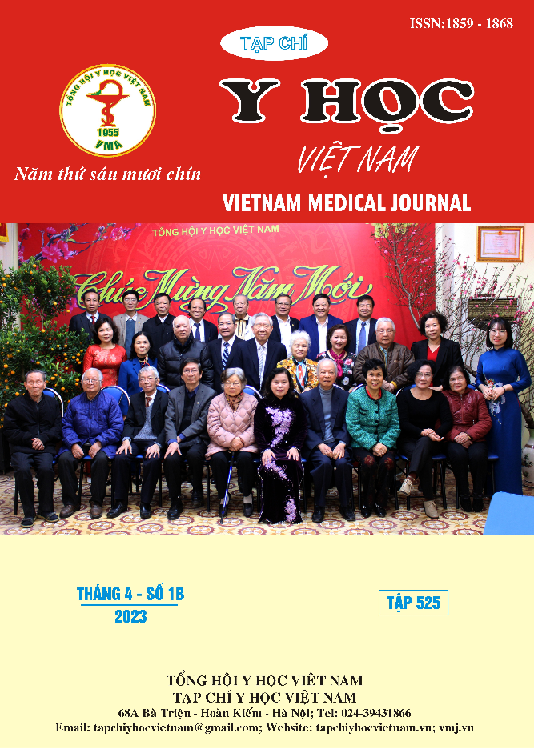CHARACTERIZATION OF THYMIC EPITHELIAL TUMORS WITH DIFFUSION AND DYNAMIC CONTRAST-ENHANCED MAGNETIC RESONANCE IMAGING
Main Article Content
Abstract
Introduction: Thymic epithelial tumor (TET) is the most common neoplasm of the adult’s anterior mediastinum. Chest magnetic resonance imaging (MRI) has been increasingly introduced into clinical practice thanks to its excellent tissue characterization and evidence of lowering the number of unnecessary interventions. Diffusion-weighted (DW) imaging provides information on the cellularity of tumors, and dynamic contrast-enhanced (DCE) technique helps to assess tumor perfusion. The present study was conducted with the aim of depicting the DW and DCE magnetic resonance (MR) findings of TETs. Methods: This is a retrospective study including 56 TET patients that underwent chest MR scanning from September 2018 to July 2022. The pathologically-proven tumors were classified into three groups according to the simplified WHO classification: low-risk thymoma (LRT), high-risk thymoma (HRT), and non-thymoma (NT). The apparent diffusion coefficient (ADC) value, time-intensity curve (TIC) pattern, and time to peak enhancement (TTP) of these tumors were recorded and compared between the three groups. Results: ADC values decreased with increasing malignancy. The ADC values were highest in LRT (median: 1.04), lower in HRT (median: 0.93), and lowest in NT (median: 0.69) (unit: x 10-3 mm2/sec). Thymoma achieved peak enhancement sooner than NT, of which the median TTP was 105 and 180 sec, consecutively. LRT (median TTP: 60 sec) reached peak enhancement earlier than HRT (median TTP: 120 sec) or NT (median TTP: 180 sec). The washout TIC was the predominant pattern in LRT (71.4%). In the HRT group and the NT group, the most common TIC pattern was the plateau (52.6% and 56.2%, respectively).Conclusion: DW and DCE-MRI are useful advanced MR tools to characterize TETs.
Article Details
Keywords
thymic epithelial tumor, thymoma, thymic carcinoma, thymic neuroendocrine tumor, diffusion magnetic resonance imaging, dynamic contrast-enhanced magnetic resonance imaging.
References
2. Shen J, Zhang W, Zhu J-J, Xue L, et al. Multiparametric Magnetic Resonance Imaging for Assessing Thymic Epithelial Tumors: Correlation With Pathological Subtypes and Clinical Stages. Journal of Magnetic Resonance Imaging. 2022; n/a(n/a)doi:https://doi.org/10.1002/jmri.28198
3. Đoàn Thái Duy. Đặc điểm hình ảnh cộng hưởng từ của u sợi và u vỏ-sợi buồng trứng 2018.
4. Yabuuchi H, Matsuo Y, Kamitani T, Setoguchi T, et al. Parotid gland tumors: can addition of diffusion-weighted MR imaging to dynamic contrast-enhanced MR imaging improve diagnostic accuracy in characterization? Radiology. 2008;249(3):909-916.
5. Priola AM, Priola SM, Giraudo MT, Gned D, et al. Diffusion-weighted magnetic resonance imaging of thymoma: ability of the Apparent Diffusion Coefficient in predicting the World Health Organization (WHO) classification and the Masaoka-Koga staging system and its prognostic significance on disease-free survival. European radiology. 2016;26(7):2126-2138.
6. Nguyễn Đức Duy. Đặc điểm mô bệnh học và mối tương quan với đặc điểm CT Scan trên mẫu phẫu thuật u tuyến ức. 2019.
7. Kickingereder P, Wiestler B, Sahm F, Heiland S, et al. Primary Central Nervous System Lymphoma and Atypical Glioblastoma: Multiparametric Differentiation by Using Diffusion, Perfusion-, and Susceptibility-weighted MR Imaging. Radiology. 2014;272(3):843-850. doi: 10.1148/ radiol.14132740
8. Sakai S, Murayama S, Soeda H, Matsuo Y, et al. Differential diagnosis between thymoma and non‐thymoma by dynamic MR imaging. Acta radiologica. 2002;43(3):262-268.
9. Lin CY, Yen YT, Huang LT, Chen TY, et al. An MRI-Based Clinical-Perfusion Model Predicts Pathological Subtypes of Prevascular Mediastinal Tumors. Diagnostics (Basel). Apr 2 2022; 12(4)doi:10.3390/diagnostics12040889
10. Yabuuchi H, Fukuya T, Tajima T, Hachitanda Y, et al. Salivary Gland Tumors: Diagnostic Value of Gadolinium-enhanced Dynamic MR Imaging with Histopathologic Correlation. Radiology. 2003;226(2):345-354. doi:10.1148/radiol.2262011486
11. Li X, Hu JL, Zhu LM, Sun XH, et al. The clinical value of dynamic contrast-enhanced MRI in differential diagnosis of malignant and benign ovarian lesions. Tumour Biol. Jul 2015; 36(7): 5515-22. doi:10.1007/s13277-015-3219-3


